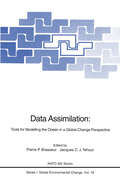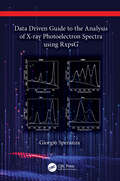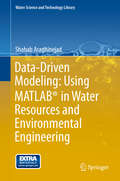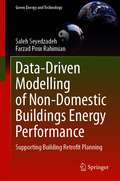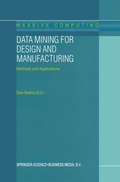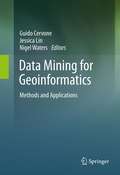- Table View
- List View
Data Analytics-Based Demand Profiling and Advanced Demand Side Management for Flexible Operation of Sustainable Power Networks (Springer Theses)
by Jelena PonoćkoThis thesis deals with two important and very timely aspects of the future power system operation - assessment of demand flexibility and advanced demand side management (DSM) facilitating flexible and secure operation of the power network. It provides a clear and comprehensive literature review in these two areas and states precisely the original contributions of the research. The book first demonstrates the benefits of data mining for a reliable assessment of demand flexibility and its composition even with very limited observability of the end-users. It then illustrates the importance of accurate load modelling for efficient application of DSM and considers different criteria in designing DSM programme to achieve several objectives of the network performance simultaneously. Finally, it demonstrates the importance of considering realistic assumptions when planning and estimating the success of DSM programs.The findings presented here have both scientific and practical significance; they gained her BSc and MSc degrees in electrical engineering from the University of Belgrade in 2011 and 2012 respectively. She graduated with her PhD from the University of Manchester. She has presented at several conferences, and has won runner-up prizes in poster presentation at three. She has authored or co-authored more than 40 journal, conference and technical papers.provide a basis for further research, and can be used to guide future applications in industry.
Data Analytics for Drilling Engineering: Theory, Algorithms, Experiments, Software (Information Fusion and Data Science)
by Qilong XueThis book presents the signal processing and data mining challenges encountered in drilling engineering, and describes the methods used to overcome them. In drilling engineering, many signal processing technologies are required to solve practical problems, such as downhole information transmission, spatial attitude of drillstring, drillstring dynamics, seismic activity while drilling, among others. This title attempts to bridge the gap between the signal processing and data mining and oil and gas drilling engineering communities. There is an urgent need to summarize signal processing and data mining issues in drilling engineering so that practitioners in these fields can understand each other in order to enhance oil and gas drilling functions. In summary, this book shows the importance of signal processing and data mining to researchers and professional drilling engineers and open up a new area of application for signal processing and data mining scientists.
Data and Models in Action: Methodological Issues in Production Ecology (Current Issues in Production Ecology #5)
by A. SteinUnder leadership of CT de Wit a large amount of modeling, building prototypes and also application, was carried out in the 1970s and 1980s. Comprehensive models were built, evaluated and carefully documented in the areas of crop growth production, plant breeding, soil water and nutrients, and in crop protection. Simulation techniques and biophysical theories developed in parallel. Simulation and experimentation always went hand in hand. Much of this work is documented in a long series of PhD theses under supervision of De Wit, in the series of Simulation Monographs (PUDOC), and in numerous other publications. This work has inspired many scientists across the global science community. The CT de Wit Graduate School of Production Ecology (PE) of the Wageningen University builds further on this platform and finds new subjects for research on and with models, and data. The PE platform provides also an excellent opportunity to develop contacts, cooperation and joint software with research groups in related fields and abroad. This book precipitates from such an exploration in new directions. We realize that modem information systems and statistics can offer a substantial contribution to the modelling framework. Good examples can be found here, and these provide a clear direction for the years to come.
Data Assimilation: The Ensemble Kalman Filter
by Geir EvensenThis book reviews popular data-assimilation methods, such as weak and strong constraint variational methods, ensemble filters and smoothers. The author shows how different methods can be derived from a common theoretical basis, as well as how they differ or are related to each other, and which properties characterize them, using several examples. Readers will appreciate the included introductory material and detailed derivations in the text, and a supplemental web site.
Data Assimilation: The Ensemble Kalman Filter
by Geir EvensenThis book reviews popular data-assimilation methods, such as weak and strong constraint variational methods, ensemble filters and smoothers. The author shows how different methods can be derived from a common theoretical basis, as well as how they differ or are related to each other, and which properties characterize them, using several examples. Readers will appreciate the included introductory material and detailed derivations in the text, and a supplemental web site.
Data Assimilation: Tools for Modelling the Ocean in a Global Change Perspective (Nato ASI Subseries I: #19)
by Jacques C. J.Nihoul Pierre P. BrasseurData assimilation is considered a key component of numerical ocean model development and new data acquisition strategies. The basic concept of data assimilation is to combine real observations via estimation theory with dynamic models. Related methodologies exist in meteorology, geophysics and engineering. Of growing importance in physical oceanography, data assimilation can also be exploited in biological and chemical oceanography. Such techniques are now recognized as essential to understand the role of the ocean in a global change perspective. The book focuses on data processing algorithms for assimilation, current methods for the assimilation of biogeochemical data, strategy of model development, and the design of observational data for assimilation.
Data Assimilation: Making Sense of Observations (Nato Science Series: Iv: Ser. #26)
by William Lahoz Boris Khattatov Richard MenardData assimilation methods were largely developed for operational weather forecasting, but in recent years have been applied to an increasing range of earth science disciplines. This book will set out the theoretical basis of data assimilation with contributions by top international experts in the field. Various aspects of data assimilation are discussed including: theory; observations; models; numerical weather prediction; evaluation of observations and models; assessment of future satellite missions; application to components of the Earth System. References are made to recent developments in data assimilation theory (e.g. Ensemble Kalman filter), and to novel applications of the data assimilation method (e.g. ionosphere, Mars data assimilation).
Data Assimilation for Atmospheric, Oceanic and Hydrologic Applications
by Seon Ki Park Liang XuData assimilation (DA) has been recognized as one of the core techniques for modern forecasting in various earth science disciplines including meteorology, oceanography, and hydrology. Since early 1990s DA has been an important s- sion topic in many academic meetings organized by leading societies such as the American Meteorological Society, American Geophysical Union, European G- physical Union, World Meteorological Organization, etc. nd Recently, the 2 Annual Meeting of the Asia Oceania Geosciences Society (AOGS), held in Singapore in June 2005, conducted a session on DA under the - tle of “Data Assimilation for Atmospheric, Oceanic and Hydrologic Applications.” nd This rst DA session in the 2 AOGS was a great success with more than 30 papers presented and many great ideas exchanged among scientists from the three different disciplines. The scientists who participated in the meeting suggested making the DA session a biennial event. th Two years later, at the 4 AOGS Annual Meeting, Bangkok, Thailand, the DA session was of cially named “Sasaki Symposium on Data Assimilation for At- spheric, Oceanic and Hydrologic Applications,” to honor Prof. Yoshi K. Sasaki of the University of Oklahoma for his life-long contributions to DA in geosciences.
Data Assimilation for Atmospheric, Oceanic and Hydrologic Applications (Vol. II)
by Seon Ki Park and Liang XuThis book contains the most recent progress in data assimilation in meteorology, oceanography and hydrology including land surface. It spans both theoretical and applicative aspects with various methodologies such as variational, Kalman filter, ensemble, Monte Carlo and artificial intelligence methods. Besides data assimilation, other important topics are also covered including targeting observation, sensitivity analysis, and parameter estimation. The book will be useful to individual researchers as well as graduate students for a reference in the field of data assimilation.
Data Assimilation for Atmospheric, Oceanic and Hydrologic Applications (Vol. III)
by Seon Ki Park Liang XuThis book contains the most recent progress in data assimilation in meteorology, oceanography and hydrology including land surface. It spans both theoretical and applicative aspects with various methodologies such as variational, Kalman filter, ensemble, Monte Carlo and artificial intelligence methods. Besides data assimilation, other important topics are also covered including targeting observation, sensitivity analysis, and parameter estimation. The book will be useful to individual researchers as well as graduate students for a reference in the field of data assimilation.
Data Assimilation for Atmospheric, Oceanic and Hydrologic Applications (Vol. IV)
by Liang Xu Seon Ki ParkThis book contains the most recent progress in data assimilation in meteorology, oceanography and hydrology including land surface. It spans both theoretical and applicative aspects with various methodologies such as variational, Kalman filter, ensemble, Monte Carlo and artificial intelligence methods. Besides data assimilation, other important topics are also covered including adaptive observations, sensitivity analysis, parameter estimation and AI applications. The book is useful to individual researchers as well as graduate students for a reference in the field of data assimilation.
Data Assimilation for the Earth System (NATO Science Series: IV: #26)
by Richard Swinbank Victor Shutyaev William Albert LahozData assimilation is the combination of information from observations and models of a particular physical system in order to get the best possible estimate of the state of that system. The technique has wide applications across a range of earth sciences, a major application being the production of operational weather forecasts. Others include oceanography, atmospheric chemistry, climate studies, and hydrology. Data Assimilation for the Earth System is a comprehensive survey of both the theory of data assimilation and its application in a range of earth system sciences. Data assimilation is a key technique in the analysis of remote sensing observations and is thus particularly useful for those analysing the wealth of measurements from recent research satellites. This book is suitable for postgraduate students and those working on the application of data assimilation in meteorology, oceanography and other earth sciences.
Data Assimilation Fundamentals: A Unified Formulation of the State and Parameter Estimation Problem (Springer Textbooks in Earth Sciences, Geography and Environment)
by Geir Evensen Femke C. Vossepoel Peter Jan van LeeuwenThis open-access textbook's significant contribution is the unified derivation of data-assimilation techniques from a common fundamental and optimal starting point, namely Bayes' theorem. Unique for this book is the "top-down" derivation of the assimilation methods. It starts from Bayes theorem and gradually introduces the assumptions and approximations needed to arrive at today's popular data-assimilation methods. This strategy is the opposite of most textbooks and reviews on data assimilation that typically take a bottom-up approach to derive a particular assimilation method. E.g., the derivation of the Kalman Filter from control theory and the derivation of the ensemble Kalman Filter as a low-rank approximation of the standard Kalman Filter. The bottom-up approach derives the assimilation methods from different mathematical principles, making it difficult to compare them. Thus, it is unclear which assumptions are made to derive an assimilation method and sometimes even which problem it aspires to solve. The book's top-down approach allows categorizing data-assimilation methods based on the approximations used. This approach enables the user to choose the most suitable method for a particular problem or application. Have you ever wondered about the difference between the ensemble 4DVar and the "ensemble randomized likelihood" (EnRML) methods? Do you know the differences between the ensemble smoother and the ensemble-Kalman smoother? Would you like to understand how a particle flow is related to a particle filter? In this book, we will provide clear answers to several such questions. The book provides the basis for an advanced course in data assimilation. It focuses on the unified derivation of the methods and illustrates their properties on multiple examples. It is suitable for graduate students, post-docs, scientists, and practitioners working in data assimilation.
Data Assimilation: Mathematical Concepts and Instructive Examples (SpringerBriefs in Earth Sciences)
by Rodolfo GuzziThis book endeavours to give a concise contribution to understanding the data assimilation and related methodologies. The mathematical concepts and related algorithms are fully presented, especially for those facing this theme for the first time. The first chapter gives a wide overview of the data assimilation steps starting from Gauss' first methods to the most recent as those developed under the Monte Carlo methods. The second chapter treats the representation of the physical system as an ontological basis of the problem. The third chapter deals with the classical Kalman filter, while the fourth chapter deals with the advanced methods based on recursive Bayesian Estimation. A special chapter, the fifth, deals with the possible applications, from the first Lorenz model, passing trough the biology and medicine up to planetary assimilation, mainly on Mars. This book serves both teachers and college students, and other interested parties providing the algorithms and formulas to manage the data assimilation everywhere a dynamic system is present.
Data Augmented Design: Embracing New Data for Sustainable Urban Planning and Design (Strategies for Sustainability)
by Ying Long Enjia ZhangThis book offers an essential introduction to a new urban planning and design methodology called Data Augmented Design (DAD) and its evolution and progresses, highlighting data driven methods, urban planning and design applications and related theories. The authors draw on many kinds of data, including big, open, and conventional data, and discuss cutting-edge technologies that illustrate DAD as a future oriented design framework in terms of its focus on multi-data, multi-method, multi-stage and multi-scale sustainable urban planning. In four sections and ten chapters, the book presents case studies to address the core concepts of DAD, the first type of applications of DAD that emerged in redevelopment-oriented planning and design, the second type committed to the planning and design for urban expansion, and the future-oriented applications of DAD to advance sustainable technologies and the future structural form of the built environment. The book is geared towards a broad readership, ranging from researchers and students of urban planning, urban design, urban geography, urban economics, and urban sociology, to practitioners in the areas of urban planning and design.
Data-Driven Farming: Harnessing the Power of AI and Machine Learning in Agriculture
by Syed Nisar Hussain BukhariIn the dynamic realm of agriculture, artificial intelligence (AI) and machine learning (ML) emerge as catalysts for unprecedented transformation and growth. The emergence of big data, Internet of Things (IoT) sensors, and advanced analytics has opened up new possibilities for farmers to collect and analyze data in real-time, make informed decisions, and increase efficiency. AI and ML are key enablers of data-driven farming, allowing farmers to use algorithms and predictive models to gain insights into crop health, soil quality, weather patterns, and more. Agriculture is an industry that is deeply rooted in tradition, but the landscape is rapidly changing with the emergence of new technologies.Data-Driven Farming: Harnessing the Power of AI and Machine Learning in Agriculture is a comprehensive guide that explores how the latest advances in technology can help farmers make better decisions and maximize yields. It offers a detailed overview of the intersection of data, AI, and ML in agriculture and offers real-world examples and case studies that demonstrate how these tools can help farmers improve efficiency, reduce waste, and increase profitability. Exploring how AI and ML can be used to achieve sustainable and profitable farming practices, the book provides an introduction to the basics of data-driven farming, including an overview of the key concepts, tools, and technologies. It also discusses the challenges and opportunities facing farmers in today’s data-driven landscape. Covering such topics as crop monitoring, weather forecasting, pest management, and soil health management, the book focuses on analyzing data, predicting outcomes, and optimizing decision-making in a range of agricultural contexts.
Data-Driven Farming: Harnessing the Power of AI and Machine Learning in Agriculture
In the dynamic realm of agriculture, artificial intelligence (AI) and machine learning (ML) emerge as catalysts for unprecedented transformation and growth. The emergence of big data, Internet of Things (IoT) sensors, and advanced analytics has opened up new possibilities for farmers to collect and analyze data in real-time, make informed decisions, and increase efficiency. AI and ML are key enablers of data-driven farming, allowing farmers to use algorithms and predictive models to gain insights into crop health, soil quality, weather patterns, and more. Agriculture is an industry that is deeply rooted in tradition, but the landscape is rapidly changing with the emergence of new technologies.Data-Driven Farming: Harnessing the Power of AI and Machine Learning in Agriculture is a comprehensive guide that explores how the latest advances in technology can help farmers make better decisions and maximize yields. It offers a detailed overview of the intersection of data, AI, and ML in agriculture and offers real-world examples and case studies that demonstrate how these tools can help farmers improve efficiency, reduce waste, and increase profitability. Exploring how AI and ML can be used to achieve sustainable and profitable farming practices, the book provides an introduction to the basics of data-driven farming, including an overview of the key concepts, tools, and technologies. It also discusses the challenges and opportunities facing farmers in today’s data-driven landscape. Covering such topics as crop monitoring, weather forecasting, pest management, and soil health management, the book focuses on analyzing data, predicting outcomes, and optimizing decision-making in a range of agricultural contexts.
Data Driven Guide to the Analysis of X-ray Photoelectron Spectra using RxpsG
by Giorgio SperanzaThis book provides a theoretical background to X-ray photoelectron spectroscopy (XPS) and a practical guide to the analysis of the XPS spectra using the RxpsG software, a powerful tool for XPS analysis. Although there are several publications and books illustrating the theory behind XPS and the origin of the spectral feature, this book provides an additional practical introduction to the use of RxpsG. It illustrates how to use the RxpsG software to perform specific key operations, with figures and examples which readers can reproduce themselves. The book contains a list of theoretical sections explaining the appearance of the various spectral features (core‑lines, Auger components, valence bands, loss features, etc.). They are accompanied by practical steps, so readers can learn how to analyze specific spectral features using the various functions of the RxpsG software. This book is a useful guide for researchers in physics, chemistry, and material science who are looking to begin using XPS, in addition to experienced researchers who want to learn how to use RxpsG. In the digital format, the spectral data and step-by-step indications are provided to reproduce the examples given in the textbook. RxpsG is a free software for the spectral analysis. Readers can find the installation information and download the package from https://github.com/GSperanza/ website. RxpsG was developed mainly by Giorgio Speranza with the help of his colleague dr. Roberto Canteri working at Fondazione Bruno Kessler. Key Features: Simplifies the use of RxpsG, how it works, and its applications. Demonstrates RxpsG using a reproduction of the graphical interface of RxpsG, showing the steps needed to perform a specific task and the effect on the XPS spectra. Accessible to readers without any prior experience using the RxpsG software. Giorgio Speranza is Senior Researcher at Fondazione Bruno Kessler – Trento Italy, Associate Member of the Italian National Council of Research, and Associate Member of the Department of Industrial Engineering at the University of Trento, Italy.
Data Driven Guide to the Analysis of X-ray Photoelectron Spectra using RxpsG
by Giorgio SperanzaThis book provides a theoretical background to X-ray photoelectron spectroscopy (XPS) and a practical guide to the analysis of the XPS spectra using the RxpsG software, a powerful tool for XPS analysis. Although there are several publications and books illustrating the theory behind XPS and the origin of the spectral feature, this book provides an additional practical introduction to the use of RxpsG. It illustrates how to use the RxpsG software to perform specific key operations, with figures and examples which readers can reproduce themselves. The book contains a list of theoretical sections explaining the appearance of the various spectral features (core‑lines, Auger components, valence bands, loss features, etc.). They are accompanied by practical steps, so readers can learn how to analyze specific spectral features using the various functions of the RxpsG software. This book is a useful guide for researchers in physics, chemistry, and material science who are looking to begin using XPS, in addition to experienced researchers who want to learn how to use RxpsG. In the digital format, the spectral data and step-by-step indications are provided to reproduce the examples given in the textbook. RxpsG is a free software for the spectral analysis. Readers can find the installation information and download the package from https://github.com/GSperanza/ website. RxpsG was developed mainly by Giorgio Speranza with the help of his colleague dr. Roberto Canteri working at Fondazione Bruno Kessler. Key Features: Simplifies the use of RxpsG, how it works, and its applications. Demonstrates RxpsG using a reproduction of the graphical interface of RxpsG, showing the steps needed to perform a specific task and the effect on the XPS spectra. Accessible to readers without any prior experience using the RxpsG software. Giorgio Speranza is Senior Researcher at Fondazione Bruno Kessler – Trento Italy, Associate Member of the Italian National Council of Research, and Associate Member of the Department of Industrial Engineering at the University of Trento, Italy.
Data-Driven Modeling: Using MATLAB® in Water Resources and Environmental Engineering (Water Science and Technology Library #67)
by Shahab Araghinejad“Data-Driven Modeling: Using MATLAB® in Water Resources and Environmental Engineering” provides a systematic account of major concepts and methodologies for data-driven models and presents a unified framework that makes the subject more accessible to and applicable for researchers and practitioners. It integrates important theories and applications of data-driven models and uses them to deal with a wide range of problems in the field of water resources and environmental engineering such as hydrological forecasting, flood analysis, water quality monitoring, regionalizing climatic data, and general function approximation. The book presents the statistical-based models including basic statistical analysis, nonparametric and logistic regression methods, time series analysis and modeling, and support vector machines. It also deals with the analysis and modeling based on artificial intelligence techniques including static and dynamic neural networks, statistical neural networks, fuzzy inference systems, and fuzzy regression. The book also discusses hybrid models as well as multi-model data fusion to wrap up the covered models and techniques. The source files of relatively simple and advanced programs demonstrating how to use the models are presented together with practical advice on how to best apply them. The programs, which have been developed using the MATLAB® unified platform, can be found on extras.springer.com. The main audience of this book includes graduate students in water resources engineering, environmental engineering, agricultural engineering, and natural resources engineering. This book may be adapted for use as a senior undergraduate and graduate textbook by focusing on selected topics. Alternatively, it may also be used as a valuable resource book for practicing engineers, consulting engineers, scientists and others involved in water resources and environmental engineering.
Data-Driven Modelling of Non-Domestic Buildings Energy Performance: Supporting Building Retrofit Planning (Green Energy and Technology)
by Saleh Seyedzadeh Farzad Pour RahimianThis book outlines the data-driven modelling of building energy performance to support retrofit decision-making. It explains how to determine the appropriate machine learning (ML) model, explores the selection and expansion of a reasonable dataset and discusses the extraction of relevant features and maximisation of model accuracy. This book develops a framework for the quick selection of a ML model based on the data and application. It also proposes a method for optimising ML models for forecasting buildings energy loads by employing multi-objective optimisation with evolutionary algorithms. The book then develops an energy performance prediction model for non-domestic buildings using ML techniques, as well as utilising a case study to lay out the process of model development. Finally, the book outlines a framework to choose suitable artificial intelligence methods for modelling building energy performances. This book is of use to both academics and practising energy engineers, as it provides theoretical and practical advice relating to data-driven modelling for energy retrofitting of non-domestic buildings.
Data-Driven Numerical Modelling in Geodynamics: Methods and Applications (SpringerBriefs in Earth Sciences)
by Alik Ismail-Zadeh Alexander Korotkii Igor TsepelevThis book describes the methods and numerical approaches for data assimilation in geodynamical models and presents several applications of the described methodology in relevant case studies. The book starts with a brief overview of the basic principles in data-driven geodynamic modelling, inverse problems, and data assimilation methods, which is then followed by methodological chapters on backward advection, variational (or adjoint), and quasi-reversibility methods. The chapters are accompanied by case studies presenting the applicability of the methods for solving geodynamic problems; namely, mantle plume evolution; lithosphere dynamics in and beneath two distinct geological domains – the south-eastern Carpathian Mountains and the Japanese Islands; salt diapirism in sedimentary basins; and volcanic lava flow. Applications of data-driven modelling are of interest to the industry and to experts dealing with geohazards and risk mitigation. Explanation of the sedimentary basin evolution complicated by deformations due to salt tectonics can help in oil and gas exploration; better understanding of the stress-strain evolution in the past and stress localization in the present can provide an insight into large earthquake preparation processes; volcanic lava flow assessments can advise on risk mitigation in the populated areas. The book is an essential tool for advanced courses on data assimilation and numerical modelling in geodynamics.
Data Mining for Design and Manufacturing: Methods and Applications (Massive Computing #3)
by D. BrahaData Mining for Design and Manufacturing: Methods and Applications is the first book that brings together research and applications for data mining within design and manufacturing. The aim of the book is 1) to clarify the integration of data mining in engineering design and manufacturing, 2) to present a wide range of domains to which data mining can be applied, 3) to demonstrate the essential need for symbiotic collaboration of expertise in design and manufacturing, data mining, and information technology, and 4) to illustrate how to overcome central problems in design and manufacturing environments. The book also presents formal tools required to extract valuable information from design and manufacturing data, and facilitates interdisciplinary problem solving for enhanced decision making. Audience: The book is aimed at both academic and practising audiences. It can serve as a reference or textbook for senior or graduate level students in Engineering, Computer, and Management Sciences who are interested in data mining technologies. The book will be useful for practitioners interested in utilizing data mining techniques in design and manufacturing as well as for computer software developers engaged in developing data mining tools.
Data Mining for Geoinformatics: Methods and Applications
by Guido Cervone Jessica Lin Nigel WatersThe rate at which geospatial data is being generated exceeds our computational capabilities to extract patterns for the understanding of a dynamically changing world. Geoinformatics and data mining focuses on the development and implementation of computational algorithms to solve these problems. This unique volume contains a collection of chapters on state-of-the-art data mining techniques applied to geoinformatic problems of high complexity and important societal value. Data Mining for Geoinformatics addresses current concerns and developments relating to spatio-temporal data mining issues in remotely-sensed data, problems in meteorological data such as tornado formation, estimation of radiation from the Fukushima nuclear power plant, simulations of traffic data using OpenStreetMap, real time traffic applications of data stream mining, visual analytics of traffic and weather data and the exploratory visualization of collective, mobile objects such as the flocking behavior of wild chickens. This book is designed for researchers and advanced-level students focused on computer science, earth science and geography as a reference or secondary text book. Practitioners working in the areas of data mining and geoscience will also find this book to be a valuable reference.
Data, Models and Analysis: The Highest Impact Articles in 'Atmosphere-Ocean'
by Guoqi Han, Hai Lin and Douw SteynThis volume contains the ten most cited articles that have appeared in the journal Atmosphere-Ocean since 1995. These articles cover a wide range of topics in meteorology, climatology and oceanography. Modelling work is represented in five papers, covering global climate model development; a cumulus parameterization scheme for global climate models; development of a regional forecast modelling system and parameterization of peatland hydraulic processes for climate models. Data rehabilitation and compilation in order to support trend analysis work on comprehensive precipitation and temperature data sets is presented in four papers. Field studies are represented by a paper on the circumpolar lead system. While the modelling studies are global in their application and applicability, the data analysis and field study papers cover environments that are specifically, but not uniquely, Canadian. This book will be of interest to researchers, students and professionals in the various sub-fields of meteorology, oceanography and climate science.





